May 18, 2020
The Best Bike Trail & Map for Tour in Wachau Valley of Danube, Austria
Active life, Culture, Guide, History, Travel
Top attractions:
Quick Navigation
Wachau Valley
Regarded as one of the most beautiful cultural landscapes of Europe, Wachau is definitely among the highlights of Austria. Stretching 35km / 21.7mi long between Melk and Krems an der Donau, Wachau has an incredible amount to offer: nostalgic cultural monuments, delightful villages between Danube and vineyards, rewarding cultural events and exhibitions, as well as the finest wine-tasting experiences imaginable.
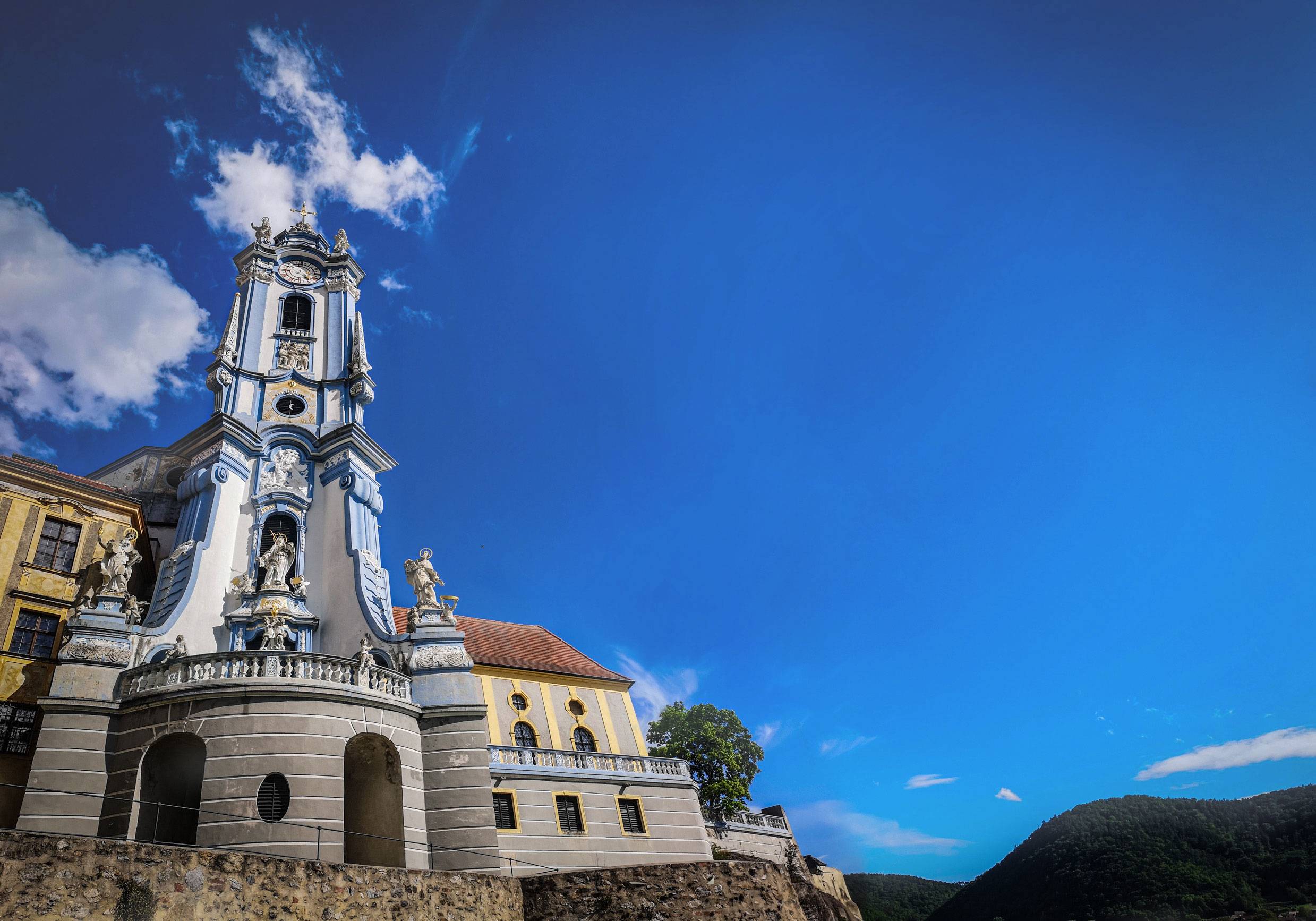
Dürnstein Abbey is the most popular tourist attraction in Wachau, despite its heartland being comprised of other four villages: Weissenkirchen, Joching, Woesendorf and St. Michael. Photo by Alis Monte [CC BY-SA 4.0], via Connecting the Dots
History of Wachau
The history of the Wachau valley stretches deep into the pre-history of Homo Sapiens. In fact, some of the oldest known art forms have been found within this majestic range of the Danube. Around 30,000 years old, Venus of Willendorf and Venus of Galgenberg are among the oldest human sculptures in the world. Could it be that the beauty of Wachau sparkled the creativity of our ancestors in a similar manner as it does today to us?
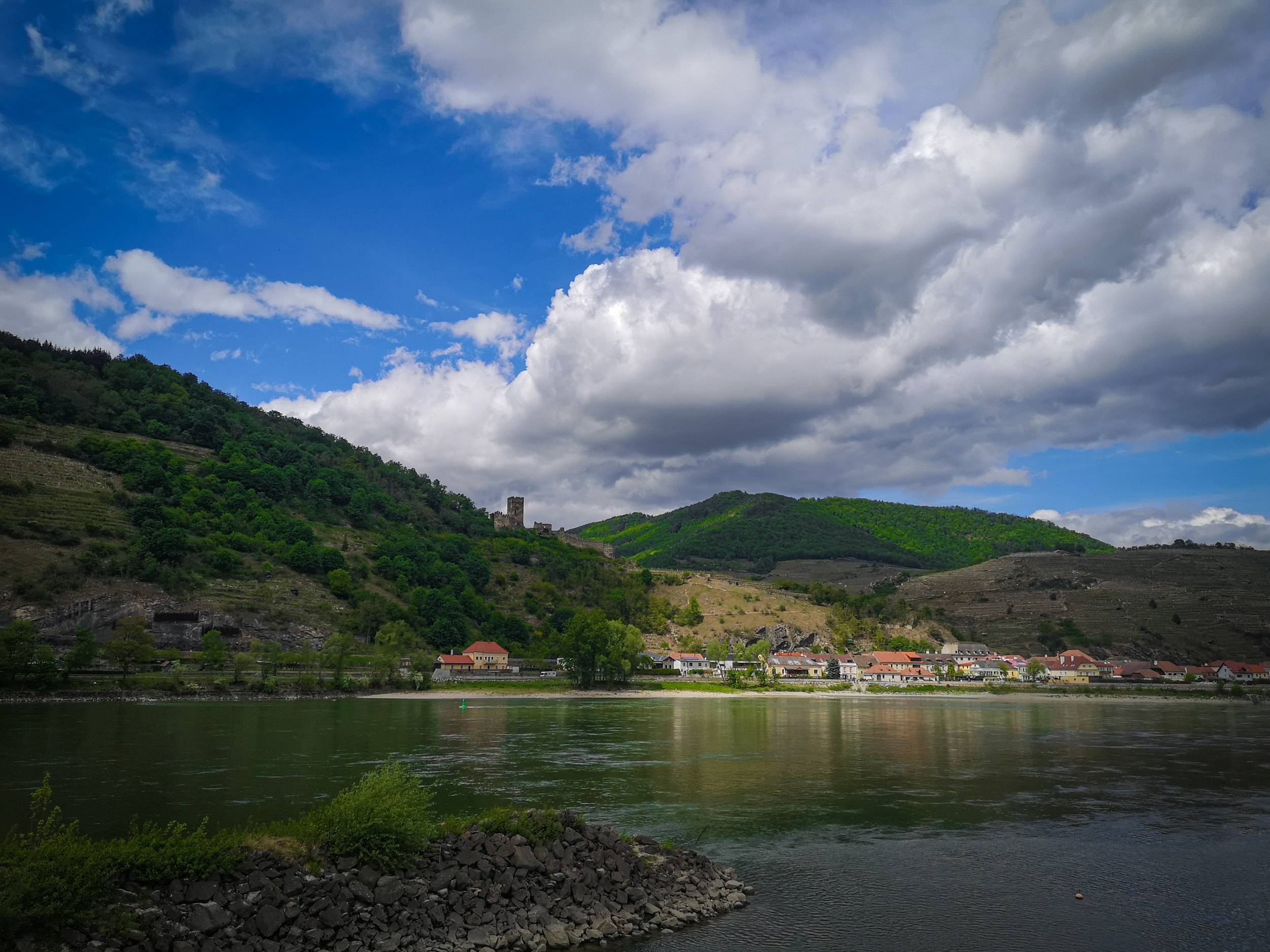
Wachau was first mentioned in 850. Photo by Alis Monte [CC BY-SA 4.0], via Connecting the Dots
The documented history of the region seems to have started in the 10th century once the Frankish Empire set its foot here. Ever since, many churches, abbeys, and castles have been built. Inevitably this produced many tales and legends, which set the foundation of the rich cultural background Wachau has.
Biking through Wachau Valley
Probably the best way to experience Wachau is on a bike. This way the legendary vineyards of the region will be open up close to you. Not only you’ll get to experience Wachau first-hard but you’ll be able to cruise past the whole distance within a day. Just imagine yourself on a bike, cycling through the countless vineyards, in a river valley surrounded by mountains & castles. That image alone is worth the journey.
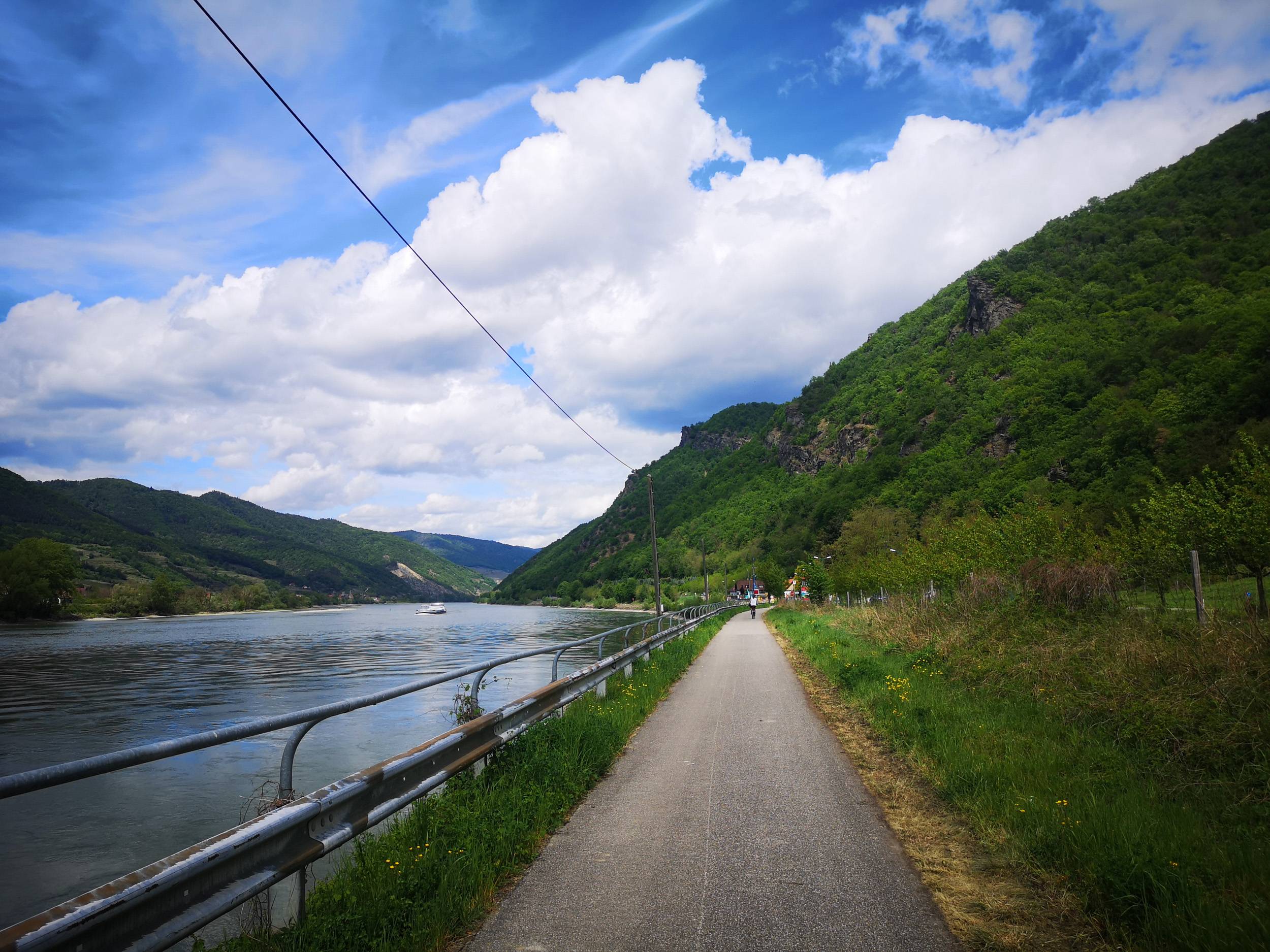
Riding a bike through Wachau will reveal more of its beauty than on a cruise ship. Photo by Alis Monte [CC BY-SA 4.0], via Connecting the Dots
Despite the bike track from Melk to Krems stretching for about 40km, you won’t even notice how was it will run by. There will be no time to get bored. Cycling alongside the Danube will reward you with beautiful sights of nature, old castles, enchanting towns and steeply terraced vineyards. The colourful trip will not only serve as a meditative experience to one’s mind but will rejuvenate the soul as well. Nothing but a gentle breeze of wind and unforgettable sights of a lifetime.
Wachau Danube River Cruise
For many reasons, biking might just be not an option for you, or maybe you want to see the Wachau Valley in a more relaxed manner. First and foremost, this is supposed to be a vacation, isn’t it? The most popular way to visit this gorgeous cultural landscape is by cruising through it by boat. There are plenty of them but from what I’ve found I would recommend the one, which serves some local food and wine. This is part of Wachau’s experience after all.
- From Krems: Wachau Valley River Cruise with 3-Course Meal (5h | from € 49/person)
- From Melk: 5-Hour Wachau River Cruise (5h | from € 35/person)
- From Vienna: Wachau and Danube Valleys Tour from Vienna (1day | from € 84/person)
Wachau Bike Route Details
- Region: Lower Austria
- Starting location: Melk
- Target location: Krems train station
- Coordinates: 48.2152 ″ N, 15.2630 ″ W
- Route: Melk – Oberarnsdorf (right side of Danube) – Spitz – Krems am der Donau (left side of Danube)
- Distance: 44km+ / 27.34mi
- Duration: 1-2 days
- Difficulty: Medium
- Permit: No
- Accomondation: Melk, Spitz, Weissenkirchen , Dürnstein & Krems
- Weather: Weissenkirchen in der Wachau
Map of Wachau Valley Cycling Route
The Best Bike Tour Direction
The side of the river is determined by the flow direction of its currents. Biking from Melk to Krems am der Donau is in the same direction as the river runs. So cycling on the right side of the Danube means that it is required to use a ferry or bridge to get to the famous Dürnstein and other wine-producing villages of the Wachau Valley.

Cycling to the same direction as Danube river flows means going downhill. Photo by A.L. [CC BY-SA 4.0], via Connecting the Dots
In my opinion, the best place to cross the Danube river is at Spitz. The range from the town to Krems an der Donau leads through the Heartland of Wachau.
Why not just ride the whole distance of Wachau on the left side of the Danube? The bike road on the right side of the river is further from the motorway and it has arguably better views. Also, this gives the possibility to climb Aggstein Castle and gets you closer to Schloss Schönbühel.

Spitz is the best place to cross Danube river for your first bike tour through Wachau valley. Photo by Alis Monte [CC BY-SA 4.0], via Connecting the Dots
Wachau Valley Cycling Tours
There is so much to do in Wachau within a day that it is probably a good idea to consider one of the many tours offered. The guide could save you a great deal of time by pinpointing the interesting locations and shortcutting to the greatest wineries. Fine wines of Wachau are an inseparable part of experiencing Wachau.
- From Vienna: Wachau Valley Winery Biking Tour (9h30 | from € 99/person) The price covers transportation from Vienna, bike & gear rental, tasting fees at all wineries, and a professional guide. Electric bikes are possible at an extra fee.
- From Vienna: Wachau Valley Full–Day Small Group E-Bike Tour (8h00 | from € 114/person) The price of the e-bike option covers transportation from Vienna, e-bike rental, an expert guide, and a single wine tasting at the end.
- From Vienna: Full-Day Kickbike Tour through Wachau (7h | from € 999/group) The price covers up to 7 people, accompanied by a professional guide. Wine tasting and transportation is included.
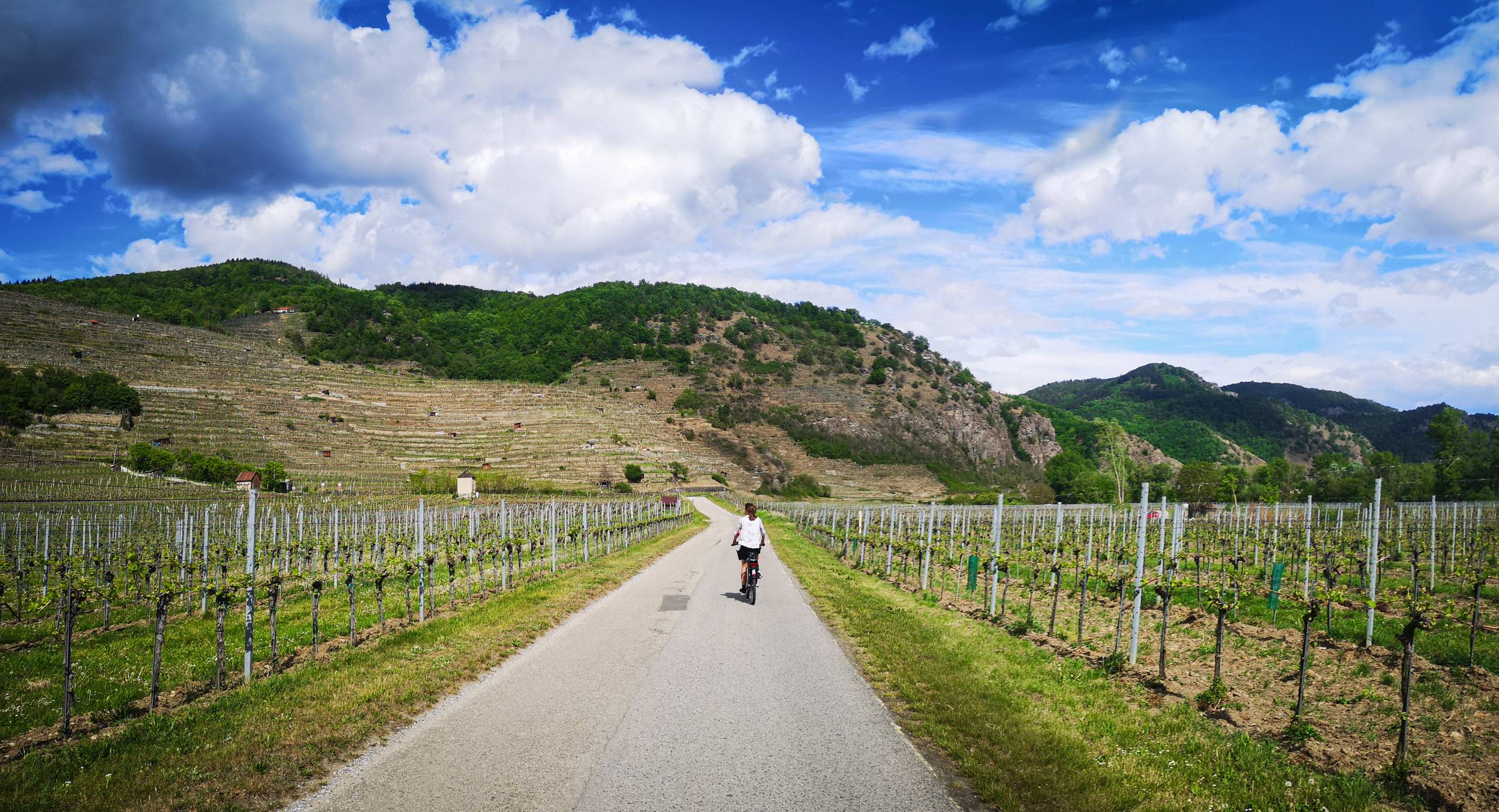
Cycling through endless vineyards of Wachau makes you feel like a part of a postcard. Photo by Alis Monte [CC BY-SA 4.0], via Connecting the Dots
History Tour Through Wachau
As I mentioned before, Wachau is one of the richest cultural landscapes in the world. It couldn’t be so without its rich past. Every single village of Wachau reveals just a part of it but together they will draw a meaningful picture. These are the highlights of the chosen right-side-to-left-side biking route.

All the credit for the map goes to the local authorities.
1.Melk
If there is only one thing somebody knows of Wachau valley before their visit, it is Benedictine Abbey of Melk (Stift Melk). Built on a craggy hillside, this magnificent Baroque masterpiece is like a golden crown to the whole town visible from every corner of Melk. It was first mentioned in 831, on a document certifying the building being a donation by Charlemagne to the monastery at Harrieden. Before that, in 791, the Franks went to war against the Avars and built a strategic border fortress on the current site of the abbey. Leopold II invited the Benedictines to Melk in 1089.

Benedictine Melk Abbey looks like a literate crown of the whole town. Photo by Alis Monte [CC BY-SA 4.0], via Connecting the Dots
Despite all that, Melk Abbey is far from being the only interesting feature of this medieval gem. The town’s medieval narrow picturesque streets serve as a gateway to an exciting journey into the past. One such place is Sterngasse. If time travel exists, it is here. Sterngasse is the oldest street in Melk, which goes following the foot of the hill beneath the abbey.
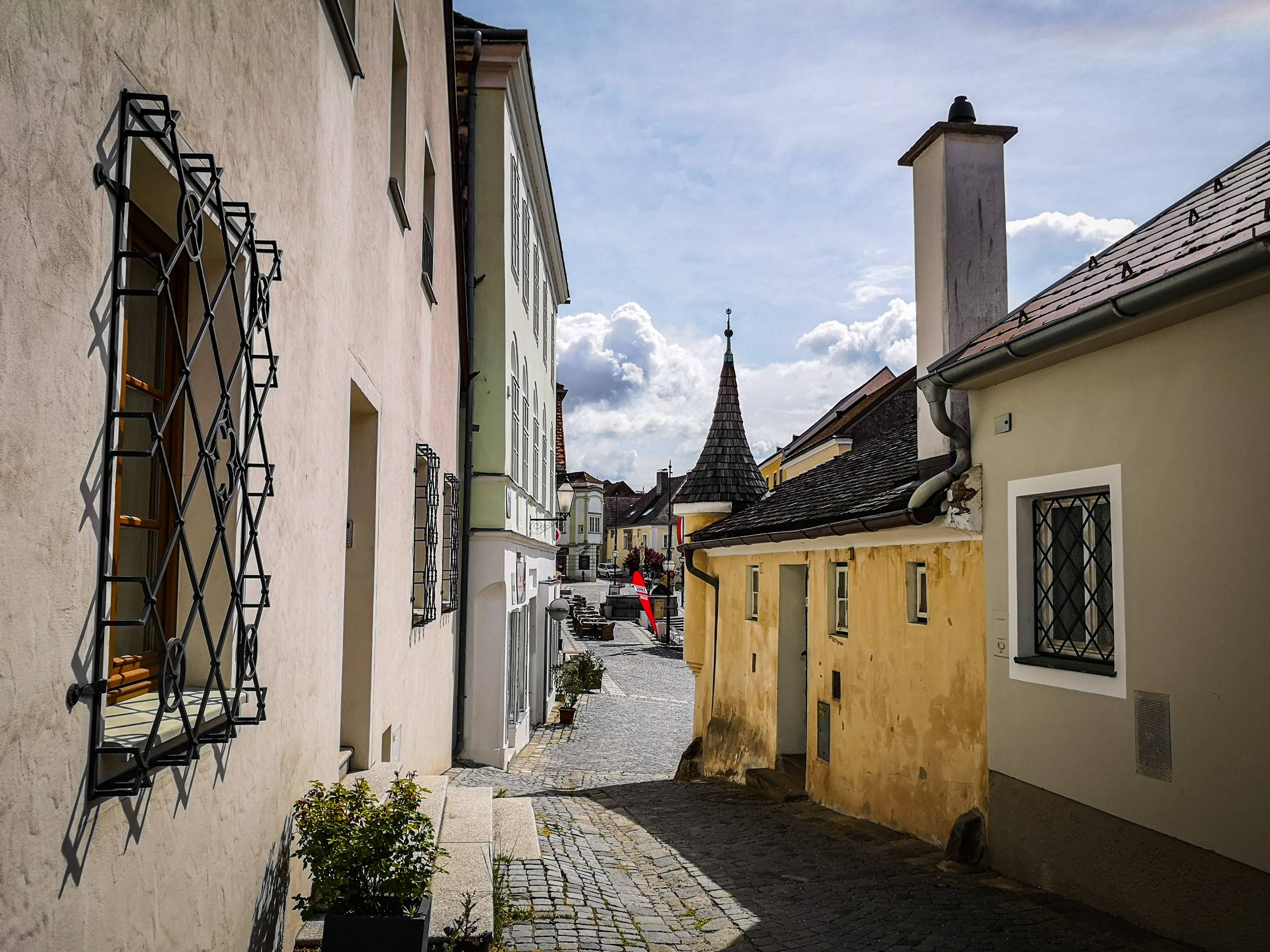
Some of the buildings ink Melk date as far as 15th century. Photo by Alis Monte [CC BY-SA 4.0], via Connecting the Dots
Even beyond the medieval Old Town, Melk will still find its ways to charm you. The very heart of the town is surrounded by numerous restaurants, shops & cafes, established in architectural jewels of Art Nouveau.
All that combined, I think Melk and its Benedictine Abbey is worth a full-day trip on its own. Thus, as eager to explore it as you probably are, I wouldn’t recommend spending more than an hour doing so. Melk is more accessible than the little towns of Wachau and that is where we are headed. Get on that bike and start performing. A long road awaits ahead.
- First mentioned: 831
- Population: 5,257 (as of 2012)
- River crossing: Bridge
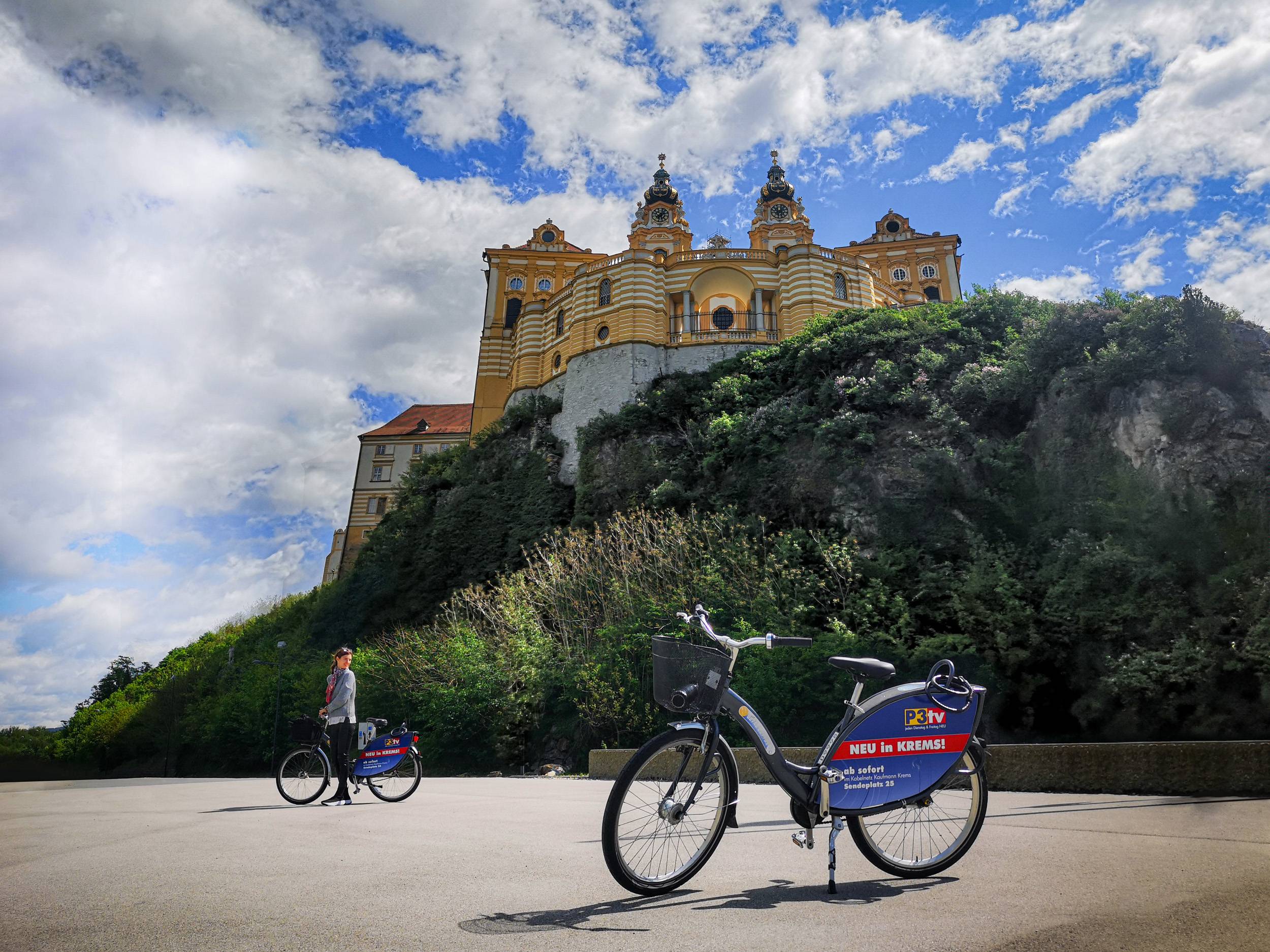
2. Schönbühel an der Donau
Just as Schönbühel wouldn’t be in the list, if it was not for its castle, the town wouldn’t exist if it was not for Schloss Schönbühel. The sole purpose of the settlement was to support the castle and its lords, which for the most part has been the House of Starhembergs. In 1819 the family sold Schloss Schönbühel together with the castle of Aggstein. Despite the change of ownership, Schönbühel Castle remains privately owned to this day.
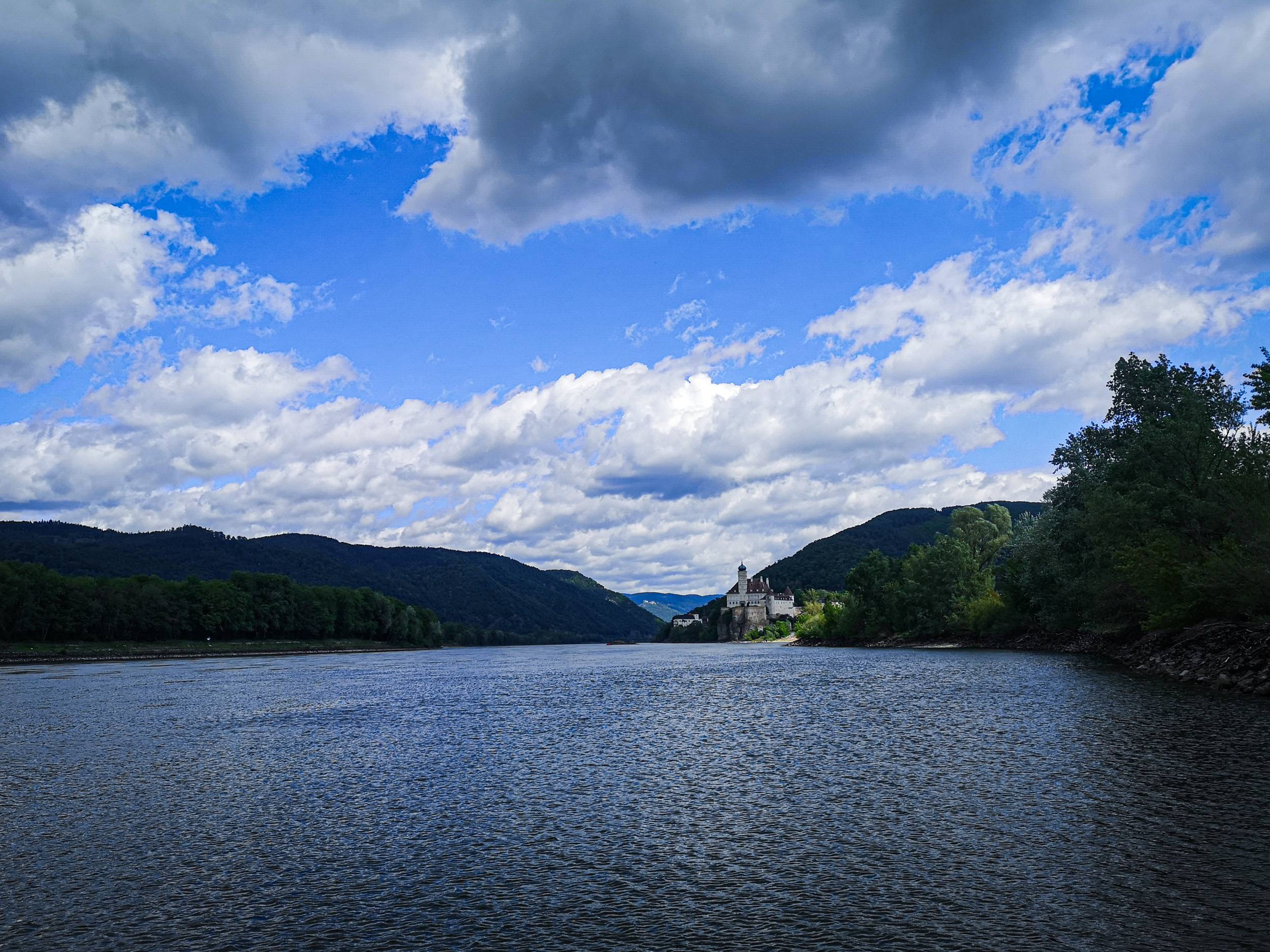
Schönbühel Castle is probably one of those places you’ll never see unless you choose to bike tour through Wachau. Photo by Alis Monte [CC BY-SA 4.0], via Connecting the Dots
Even without the possibility to visit its castle, Schönbühel an der Donau is a sight worth seeing. Schloss Schönbühel could be seen from afar, standing high on the rocks, right next to the majestic Danube. The whole fairy-tale-like image lacks only a dragon flying by. The castle is a true wonder to start off the magical journey, the road through Wachau is.
- First mentioned: 9th Century
- Population: 332 (as of 2015)
- River crossing: None
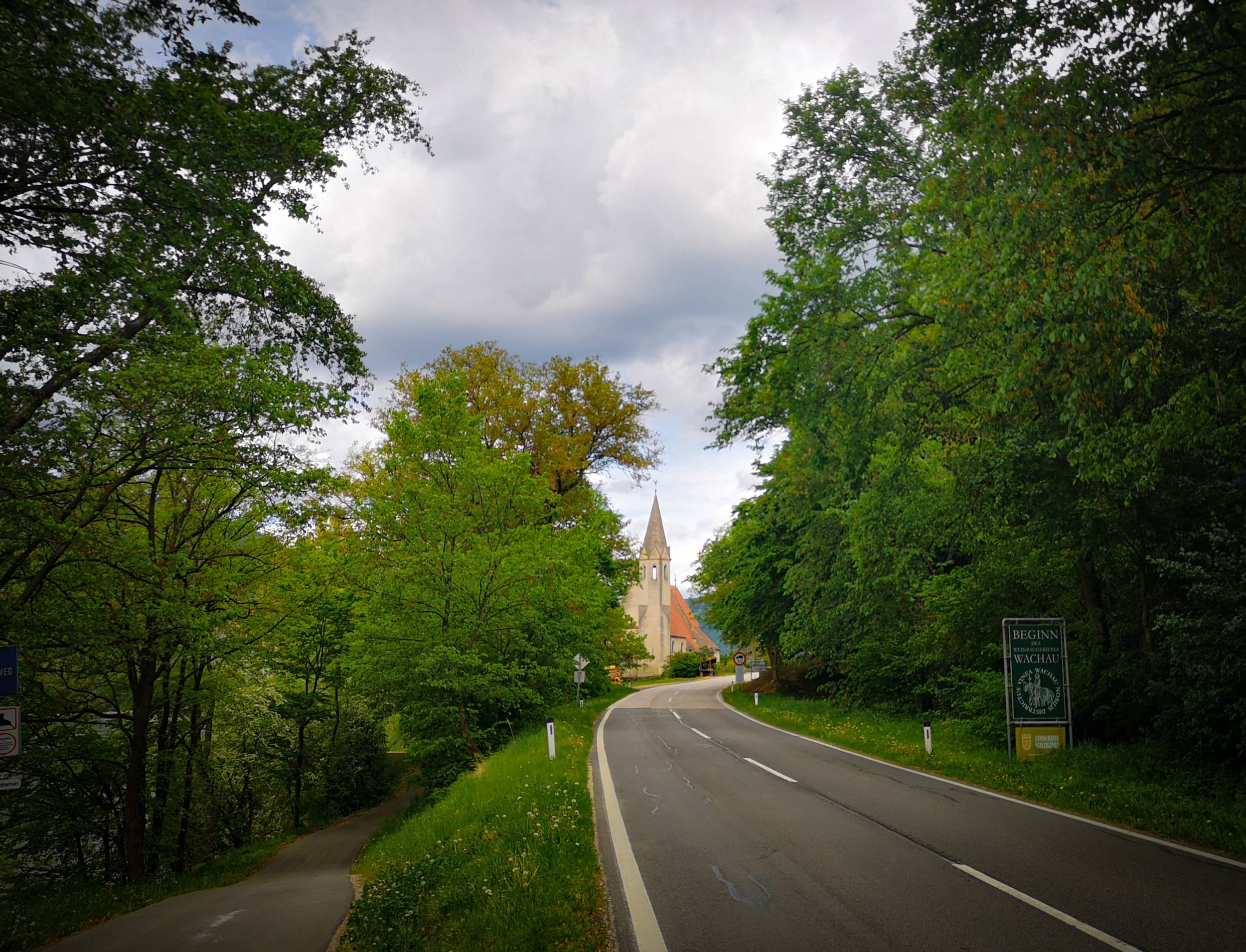
The official starting-end of Wachau. Photo by Alis Monte [CC BY-SA 4.0], via Connecting the Dots
3.Aggsbach
Further down the stream, the castle of Aggstein could be seen from afar. Together with several settlements, the castle is a part of Aggsbach. Though the castle of Aggstein is located a bit further from the Danube on a 300 m height mountain, the castle is impossible to miss. From this distance, the fortress might look small but that is just an optical illusion. The Aggstein Castle was destroyed at least two times but soon another one was rebuilt on the spot. The earliest version of the castle was probably built in the 12th century and was associated with the House of Keunringers. Today, Aggstein Castle is one of the most popular tourist attractions in the Lower Austria region.

The Castle of Aggstein is located on the right bank of Danube. Photo by Alis Monte [CC BY-SA 4.0], via Connecting the Dots
Having all this in mind, this dreamlike castle is not what Aggsbach is most famous for. That would be the ~28,000 years old Venus of Willendorf. At the spot where it was found, in the fields of Willendorf it is possible to see a real size copy of this ancient statue but the high prize itself could be seen in the Museum of Natural History in Vienna.
- First mentioned: 1148
- Population: 643 (as of 2018)
- River crossing: None

The ferry moves from shore to shore dragged by a wire attached to motors on each side of Danube. Photo by Alis Monte [CC BY-SA 4.0], via Connecting the Dots
4.Spitz
After crossing the Danube to Spitz we finally get to taste some of those beautiful towns observed on our way up until now. From the other side of the river, Spitz looked just like another little town surrounding its church in a shadow of mountains. The only difference is the Castle, standing high above the tip of the church’s tower. Once the Danube is crossed, the beauty of Wachau villages and vineyards finally reveals itself.
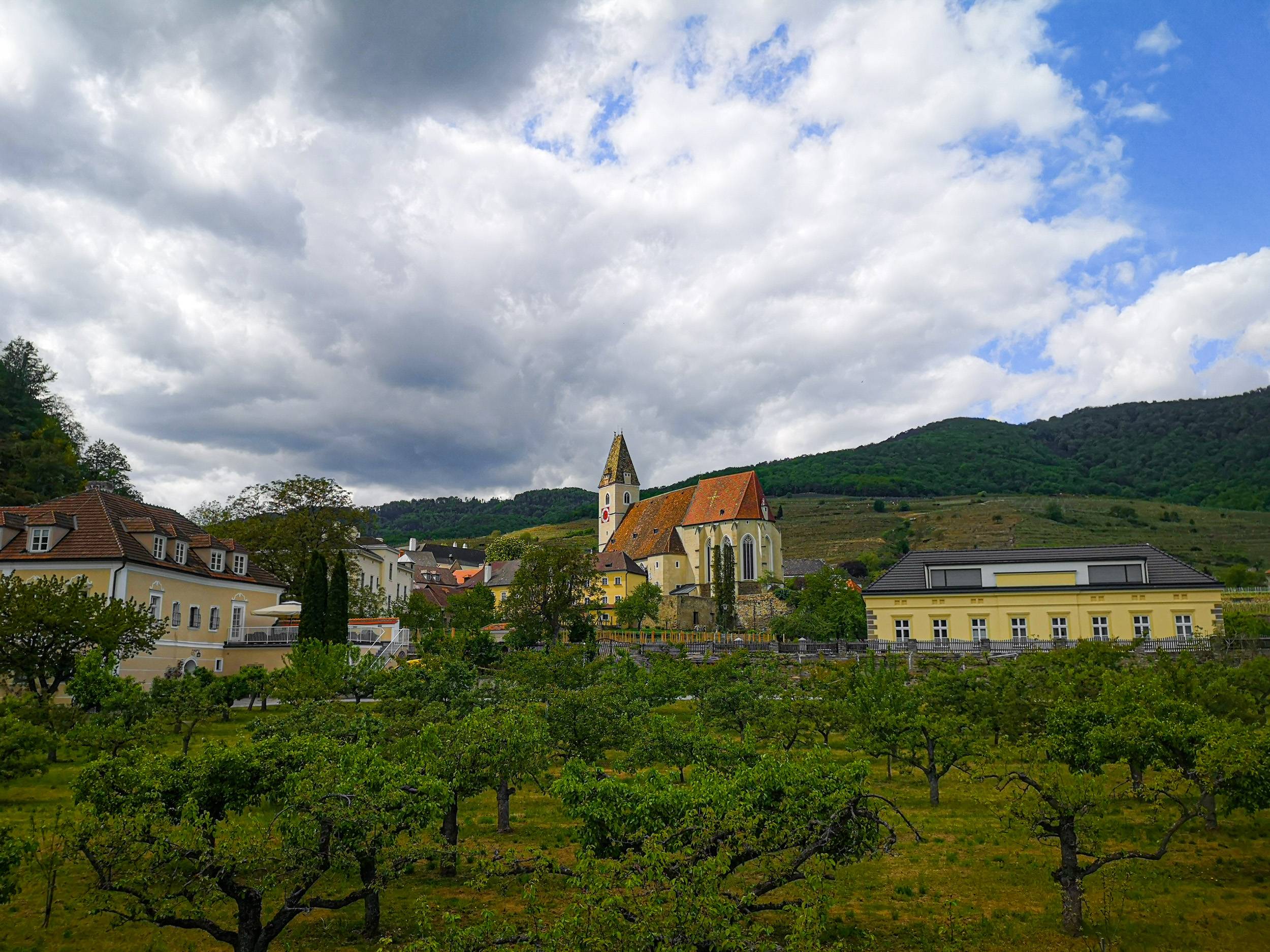
Don’t just pass-by Spitz, it is well worth exploring. Photo by Alis Monte [CC BY-SA 4.0], via Connecting the Dots
The beauty of the layout of Spitz is almost straight from a fairy tale. All of the medieval streets seem to lead uphill towards the beautiful Late-Gothic Mauritius Church. The Old Town is surrounded by elegant old grape collection stations from the Renaissance with vineyards going as far as you see. Spitz is the home to Tausendeimerberg, a legendary wine mountain, which is said to produce 1000 buckets of wine (56,000l, or 74,600 bottles) in bountiful years.
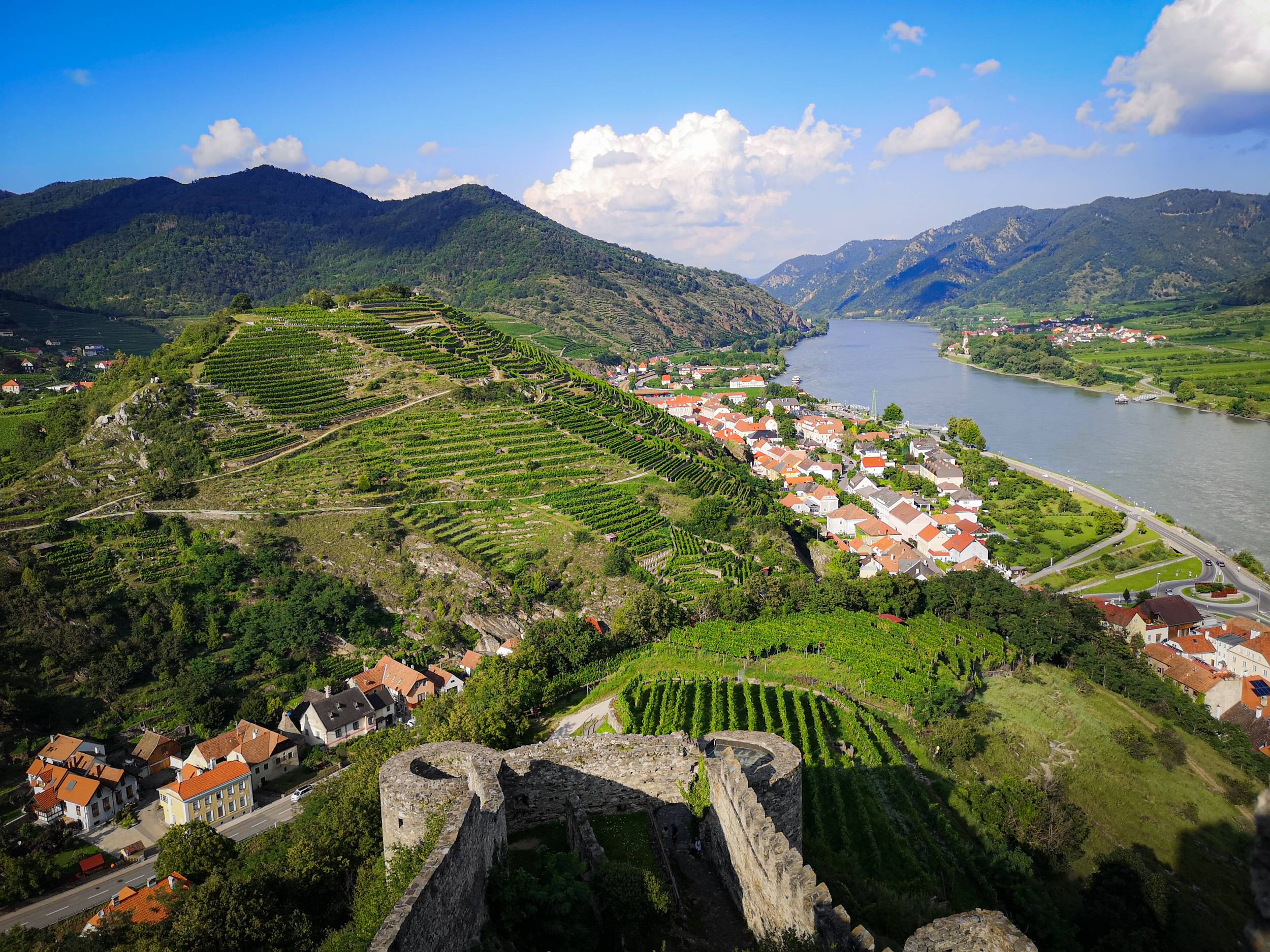
Spitz and Tausendeimerberg from Hinterhaus Castle. Photo by Alis Monte [CC BY-SA 4.0], via Connecting the Dots
The scenery is so idyllic that it feels like the medieval Old Town of Spitz is just a dummy built for a Hollywood movie, or maybe it is straight out of a painting. One way or another it is well worth your time exploring this marvellous underrated gem of Wachau. You can learn more about Spitz in this article.
- First mentioned: 830
- Population: 1,636 (2015)
- River crossing: Ferry
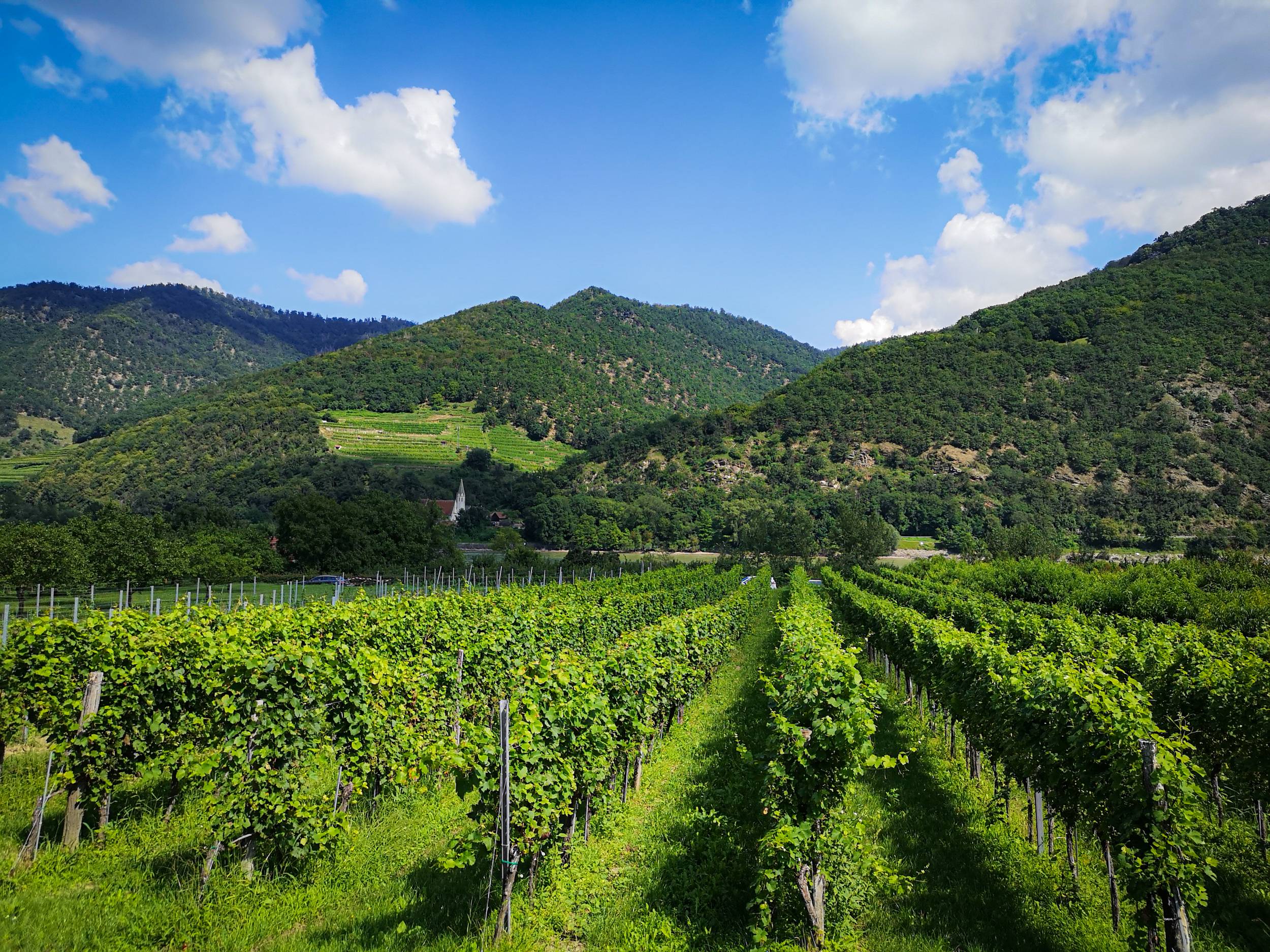
Crossing Danube will bring you from nature to the cultural landscapes of Wachau. Photo by Alis Monte [CC BY-SA 4.0], via Connecting the Dots
5.St Michael
St Michael is rather a church than a village but due to its fortified nature and the landscape, where it was built, the church is definitely one of the highlights found along the road. St Michael Church has long been the ‘Mother Church’ of the whole region of Wachau. All thanks to the age of the church. One has to dig really deep into history to find its roots.
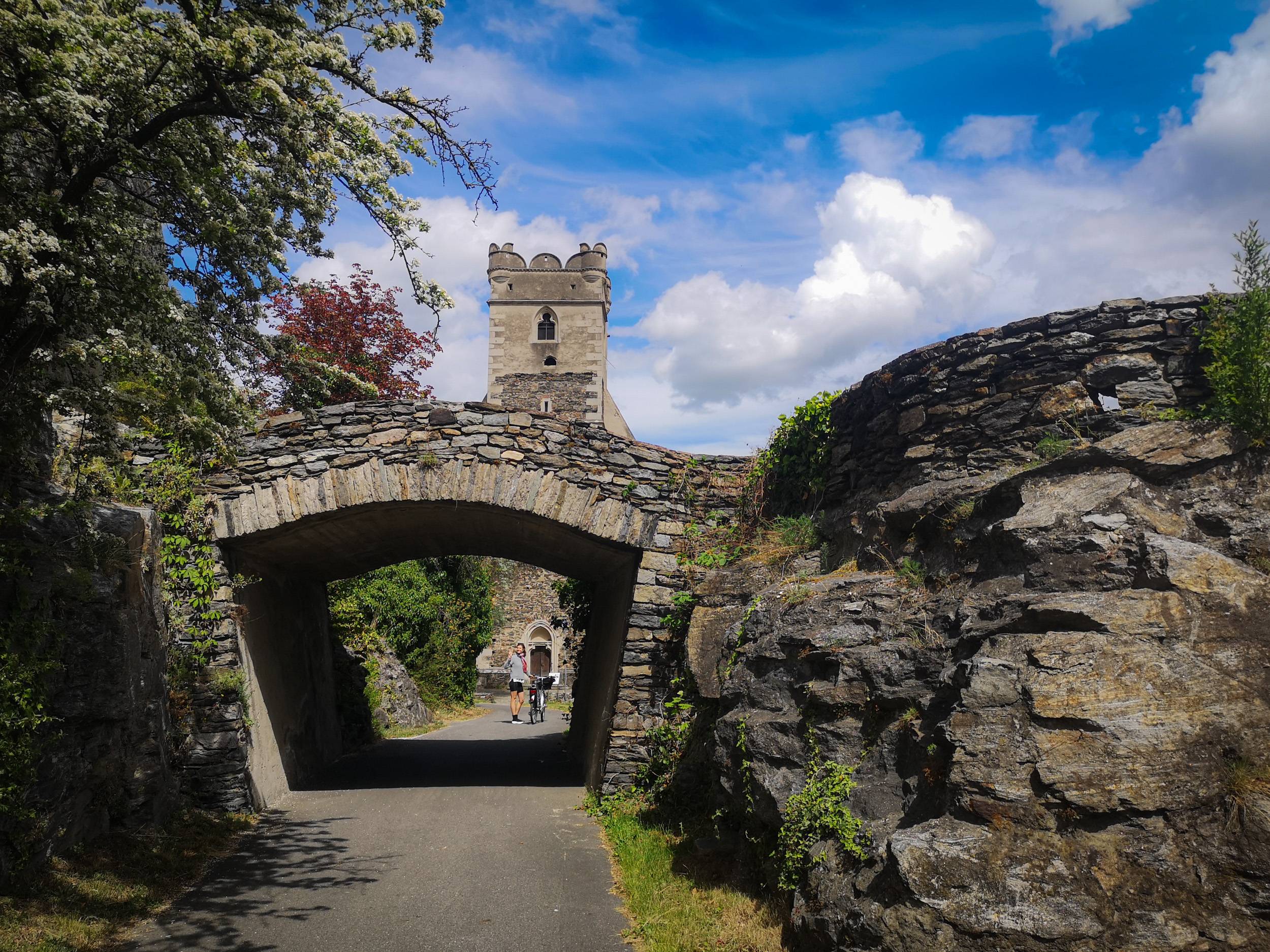
St Michael is like the gateway to the heart of Wachau. Photo by Alis Monte [CC BY-SA 4.0], via Connecting the Dots
The first shrine dedicated to St Michael was built at the site around 800 CE by Charlemagne. Even before it, this place was sacred to the Celtic people and who knows how far that goes. The Venus of Willendorf was found just around the corner. In 1784, the parish of St Michael was dissolved by Emperor Joseph II and put under the umbrella of Wösendorf.

St Michael is the place where Christian Wachau has originated. Photo by Alis Monte [CC BY-SA 4.0], via Connecting the Dots
The present-day fortified church originates from 1500 CE but its interior was rebuilt in Baroque style after a fire in 1630. The whole complex of St Michael Church included an escape tunnel, watch-out towers, and the main tower, which is suited for defence in its narrow staircase. In a case of siege, there was enough space to gather all the inhabitants and their cattle of the surrounding area.
- First mentioned: 987
- Population: 24 (2019)
- River crossing: None
6. Wösendorf in der Wachau
This is where you’ll get the first taste of cycling through the vineyards of Wachau. Wösendorf is separated from St Michael by fields of Riesling and Grüner Veltliner white grapes. Those who appreciate fine wines will surely appreciate the sights of Domäne Wachau.

This is where those tasty wines are coming from. Photo by Alis Monte [CC BY-SA 4.0], via Connecting the Dots
Riding a bike through Wachau vineyards gives a feeling of being a part of a postcard or a label on the bottle of wine from Wachau. This gives a surreal feeling of suddenly becoming a part of this cultural landscape. Like you belong here. It is hard to abandon that sense, but there is still a long road ahead. Together with it – more picturesque vineyards.

Be sure not to miss this little gem, the church of Wösendorf in der Wachau is. Photo by Alis Monte [CC BY-SA 4.0], via Connecting the Dots
From Wösendorf, it is hard to tell, when one village starts and another ends. I highly recommend exploring each one of them. You never know what could be hiding under the next corner. Wösendorf is to not be underestimated. The town stands on the top of a stone-age settlement. Ancient as it is, the building material doesn’t seem to have changed that much ever since. From the narrow cobblestone streets to its Baroque church and the marketplace. Everything in this town seems to be built from stone.
- First mentioned: 1163
- Population: 295 (2019)
- River crossing: None
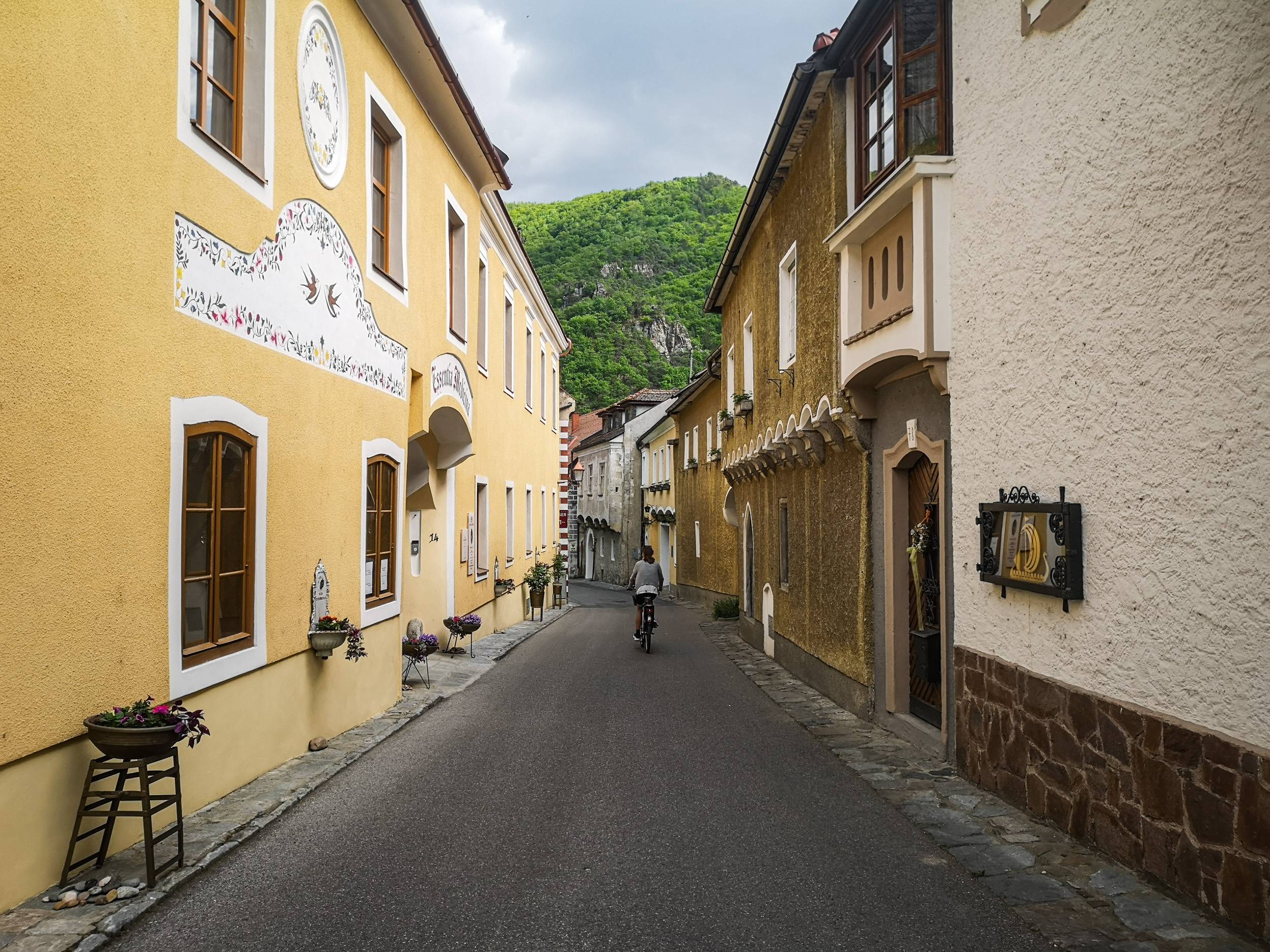
It is hard to tell once one village starts and another ends. Photo by Alis Monte [CC BY-SA 4.0], via Connecting the Dots
7.Joching
Despite its small size, Joching could be easily the most charming village out of them all. The streets of Joching seems to be even narrower and the houses even more colourful. Despite its size, Joching importance to the fine-wine-making tradition in Wachau is great. It is winemakers’ village after all. Wineries of Joching played a major role in innovating throughout the centuries and some even associate the village with the origins of Riesling.
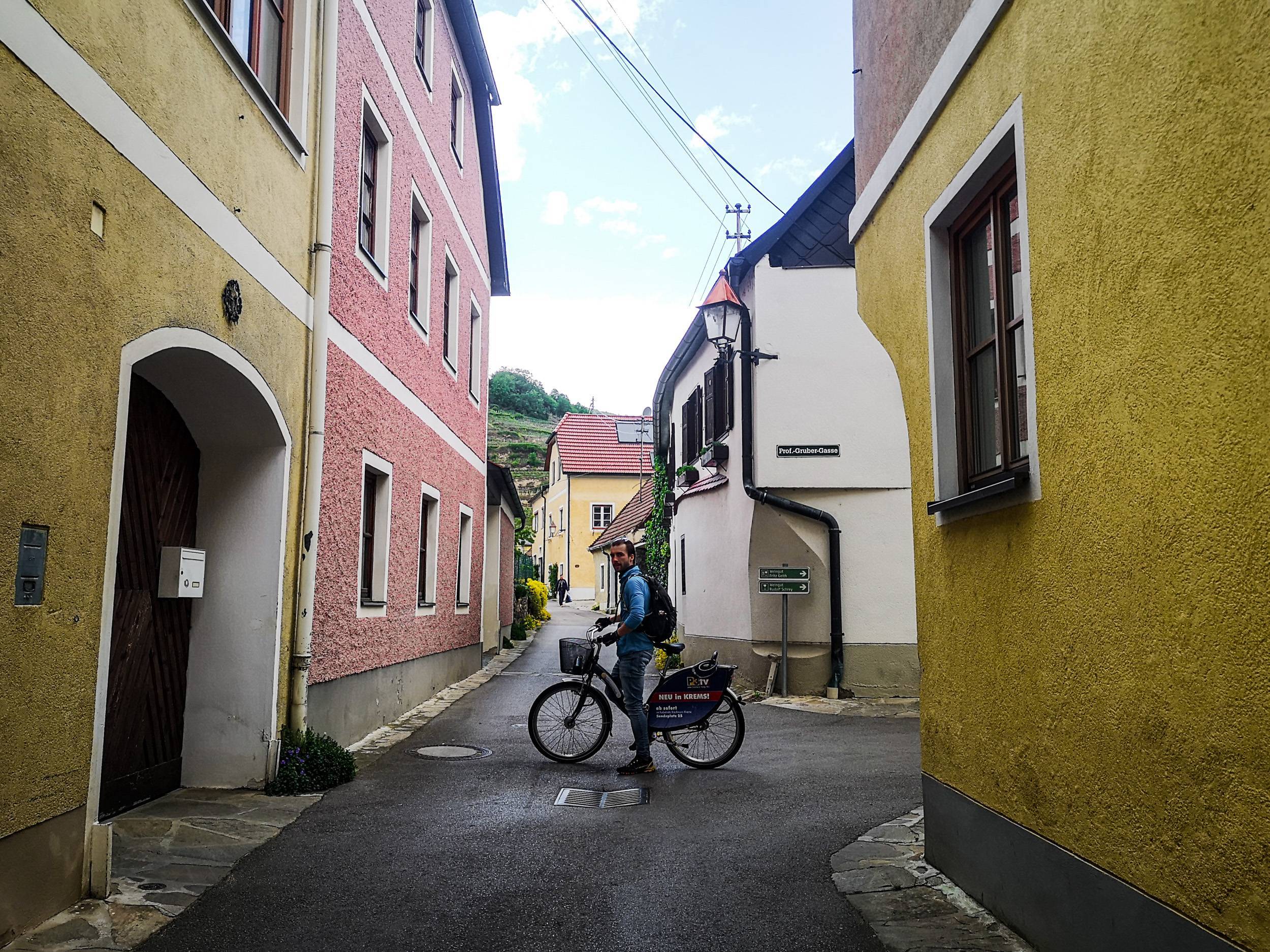
Don’t skip the chance to explore the narrow streets of these charming villages. Photo by A.L. [CC BY-SA 4.0], via Connecting the Dots
Take your time to appreciate Joching because you might not even notice once you pass it. Pleasant as it is, it is also easy to miss. Joching is not only famous for its fine wines but for the snacks served in heurigers. They are famous for creating their own dishes annually but don’t worry – traditional Wachau snacks could be found here as well.
- First mentioned: 1259
- Population: 156 (2019)
- River crossing: None

St Michael, Wösendorf in the Wachau, Joching and Weissenkirchen in der Wachau is actually under one municipality. Photo by Alis Monte [CC BY-SA 4.0], via Connecting the Dots
8.Weissenkirchen in der Wachau
Accounting for less than 1/40th of the total area of Wachau, the Weissenkirchen community has more than 1/3rd of the entire wine-cultivating land of the region. Having such resourceful land it shouldn’t be a surprise that this lovely town has way more to offer than just wine, which – I have to tell – is great. That should be no surprise, the wine in Weissenkirchen has been cultivated for more than a thousand-year now. There are old documents mentioning the vineyards of the town being owned by Niederaltaich Abbey in 830.

Why the church of Weissenkirchen, Teisenhoferhof, is fortified? To protect the citizens of the town from the Turks, who had expanded the Ottoman Empire right next to Vienna. Photo by Alis Monte [CC BY-SA 4.0], via Connecting the Dots
It is not surprising that being so old, Weissenkirchen is full of historic houses, which once were the home to prosperous merchants and the age-less wineries with all the old wine-making assemblies imaginable. Not to mention the old mansions of prosperous wine estates – architectural jewels of bygone days, and Teisenhoferhof, the fortified church of Weissenkirchen, which will leave absolutely everybody impressed. Next to it stands the oldest primary school in Austria. It was first mentioned in 1385. All of this and more in one small town Weissenkirchen in der Wachau.
- First mentioned: 830
- Population: 941 (2019)
- River crossing: Ferry
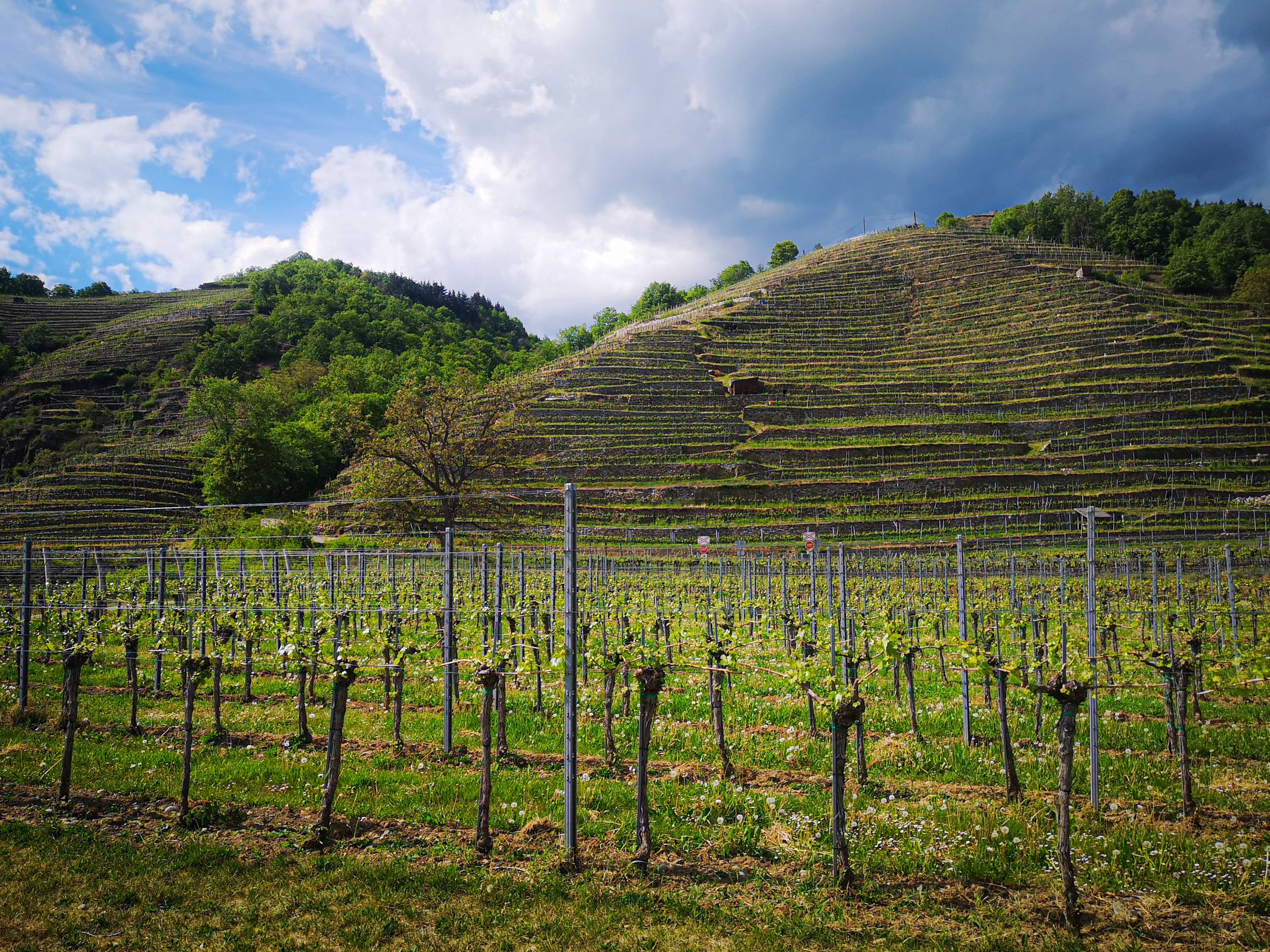

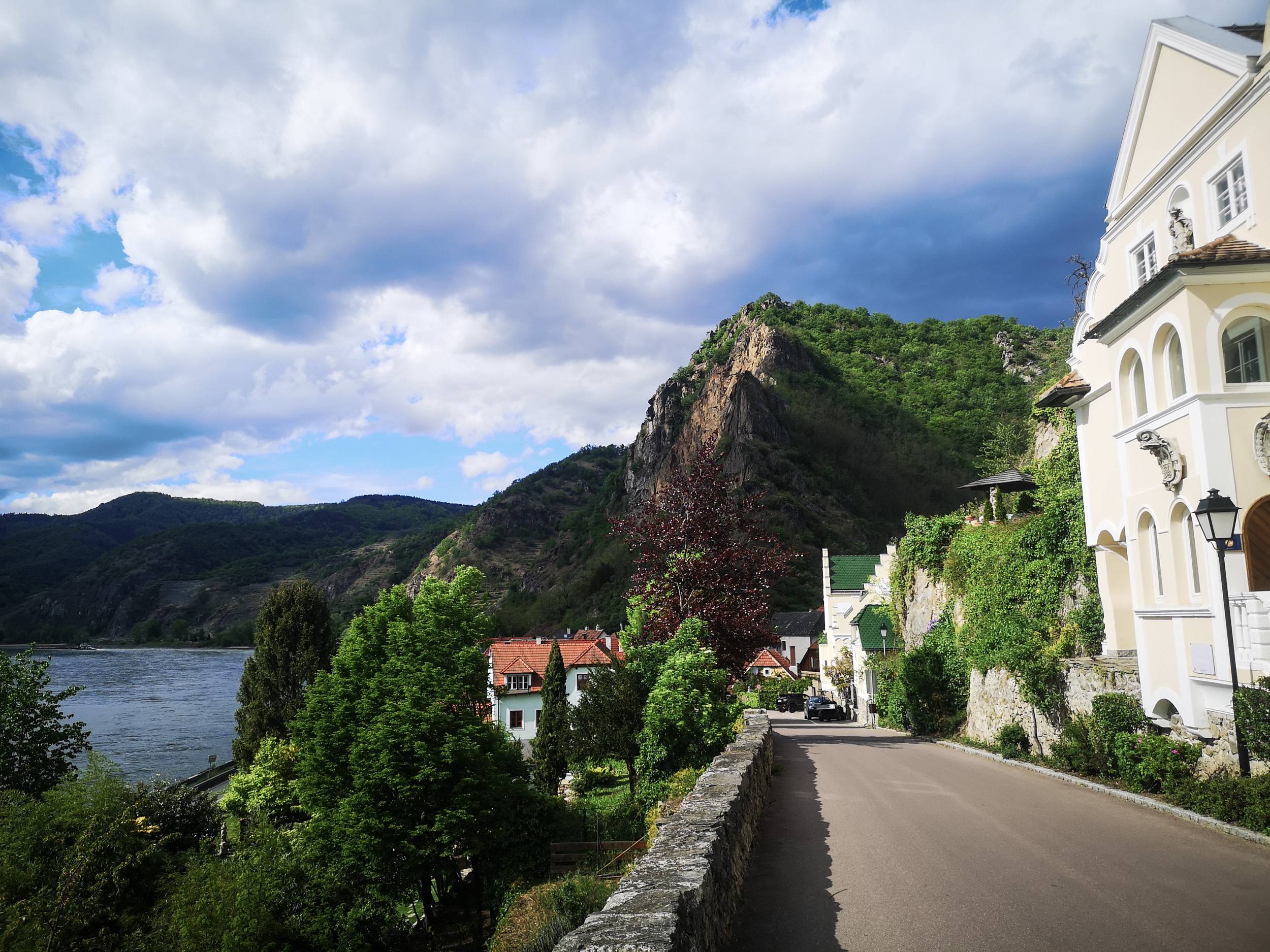
From German to English, Dürnstein translates to “Dry Stone”. Photo by Alis Monte [CC BY-SA 4.0], via Connecting the Dots
9. Dürnstein
Everybody’s favourite right? Even in 2020, Dürnstein was filled with visitors. That is not without a reason, the town is not shy of its legends and beautiful historic architectural building. At the centre of it – “God’s Finger” – is the blue-and-white tower of a former Dürnstein (Stift Dürnstein), established in 1410 by Augustinian Canons. This Baroque tower is probably the icon of the whole Wachau region. Sceptical I was, I must say it is probably the most uniquely beautiful church tower I’ve seen so far.
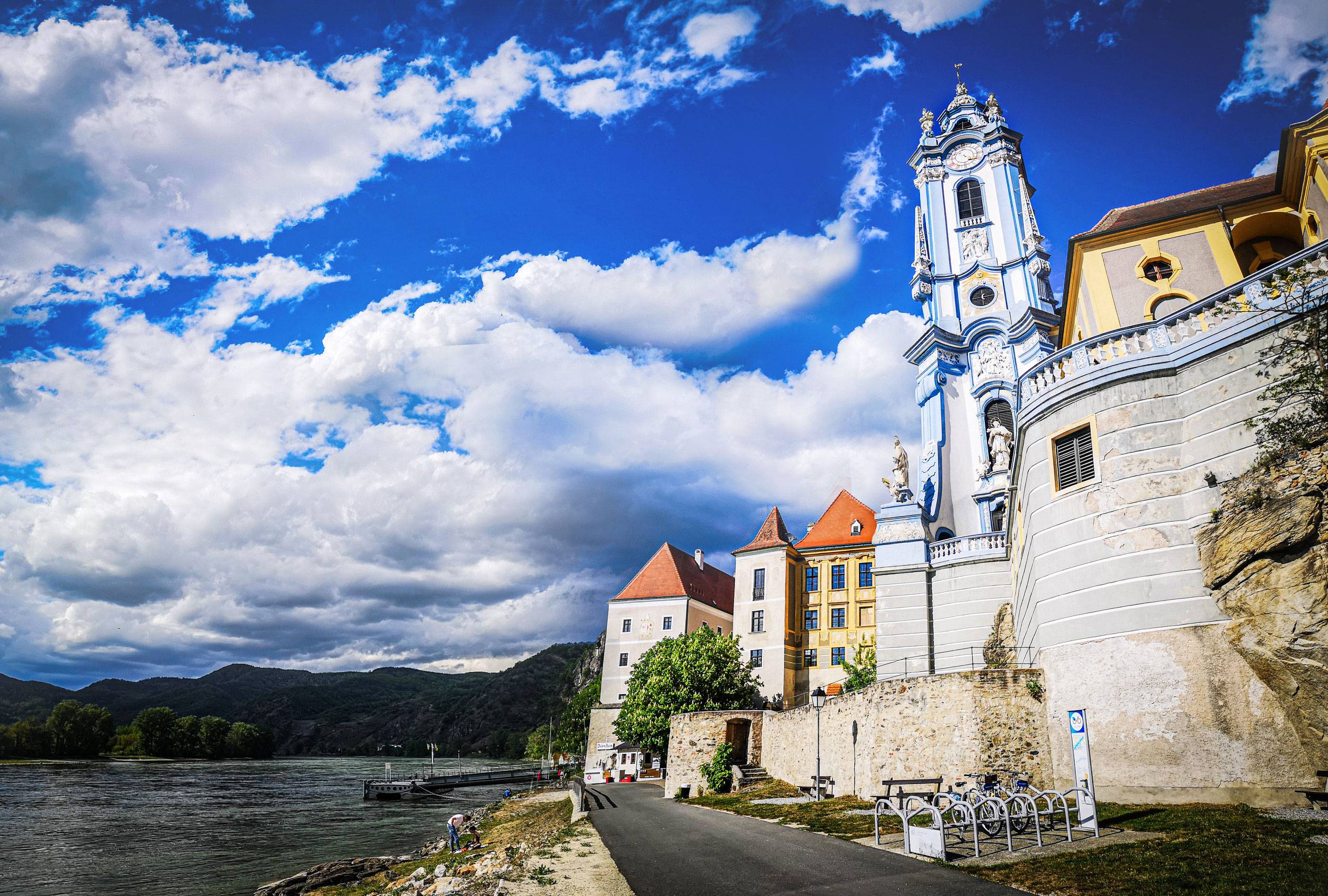
Undoubtedly, Dürnstein holds the title of the most picturesque town of Wachau, hence its popularity. Photo by Alis Monte [CC BY-SA 4.0], via Connecting the Dots
Dürnstein was first mentioned in 1192 for a reason, which romantically echoes in our minds to this day. The castle ruin, high above the city was the place, where Leopold V, Duke of Austria, imprisoned King Richard I of England after a dispute during the Third Crusade. If you want to see it, there is a road leading from Dürnstein straight to the castle. I’m sure it won’t be hard to find it. After 30 minutes of walking will surprise you with the beautiful panorama of the valley. Both, beautiful hikes and the history of Dürnstein, make this town one of the top tourism gems in the whole of Wachau.
- First mentioned: 1192
- Population: 861 (2015)
- River crossing: Ferry

The area of Krems an der Danau has been inhabited from the stone age. Within the city, the 27,000-year-old grave of a young boy was found. Photo by Alis Monte [CC BY-SA 4.0], via Connecting the Dots
10.Krems an der Danau
Due to its size, Krems an der Danau is an obvious cultural and industrial center in the valley of Wachau. Over a millennia-old, the city is well known for its charm and wines. It is a perfect mixture of traditional and modern. Though Krems population now is just below 25,000, between 11st and 12th centuries the city was almost as big as Vienna. Since then, the Old Town of the city remained almost unchanged, so it is no surprise that to this day it is the main attraction of Krems.

The parish church of Krems and der Donau is known as “The Cathedral of Wachau”. Photo by Alis Monte [CC BY-SA 4.0], via Connecting the Dots
Some notable places are the parish church of the town, also known as the “Cathedral of the Wachau” and Obere Landstrasse, the main street of the Old Town. After all the fairy-tale villages visited before, Krems an der Danau might look a bit underwhelming. Given the circumstances, I consider it normal but compared to other cities of Austria of a similar size, Krems is truly a charming place.
- First mentioned: 995
- Population: 24,011 (2015)
- River crossing: Bridge
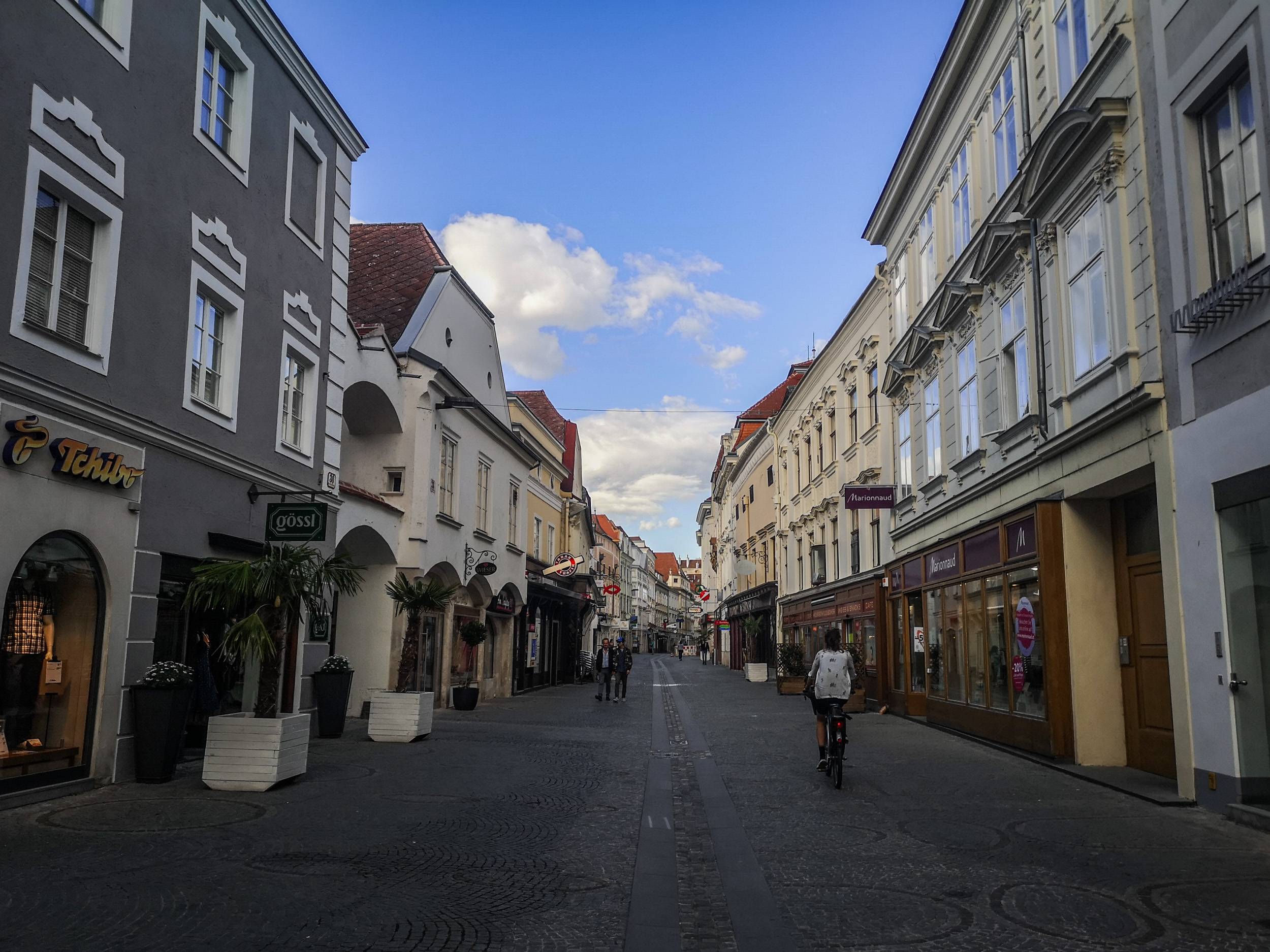
The train station is not that far from Obere Landstrasse and this is where this colorful journey ends. Photo by Alis Monte [CC BY-SA 4.0], via Connecting the Dots
My Impressions of Biking through Wachau
For such a small country, Austria has surprisingly a lot to offer. Wachau is a good representation of it. Traveling by bike is the best way to see most of Wachau within a day, but even that won’t be enough to fully experience this picturesque region. There is simply not enough time to explore every street, taste every wine, take every shot, and climb every castle. Wachau has simply too much to offer for a single day. If you want to experience any given area of the Wachau Valley in more detail – Wachau World Heritage Trail might be just for you. Having in mind the nature of Wachau’s landscape, it just asks for a second visit to the other side of the Danube. There is a reason why I list Wachau on the top of the best Vienna wine hiking trips. Believe me – this will be in your head after your first trip. Why not succumb to it?

Biking through Wachau could be easily THE ADVENTURE of your visit to Austria. Photo by A.L. [CC BY-SA 4.0], via Connecting the Dots
Saving time, many people visit only the highlights of Wachau, like Melk Abbey, or God’s Finger of Dürnstein. Sure, both are marvelous but are they alone a good representation of the region? I don’t think so. Actually, it is not even close. The beauty of Melk Abbey or God’s Finger in Dürnstein wouldn’t be so if it was not for the culture and the actual richness of Wachau. All thanks to the fine wines, produced here. I guarantee you haven’t seen the region if you haven’t cycled through it, visited every lovely town, and tasted the fine wines of Wachau.

It is impossible to get bored of this typical landscape of Wachau valley. Photo by Alis Monte [CC BY-SA 4.0], via Connecting the Dots